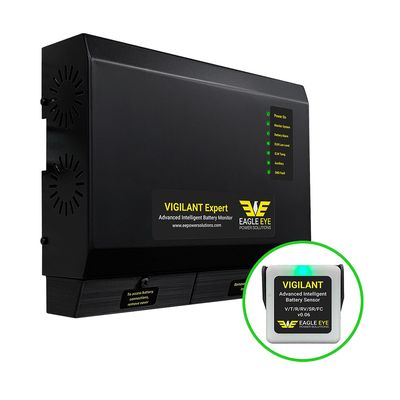

Eagle Eye Power Solutions, LLC
- Home
- Companies
- Eagle Eye Power Solutions, LLC
- Products
- Eagle Eye VIGILANT - Model BMS - ...

Eagle Eye VIGILANT - Model BMS - Battery Monitoring System
The ground-breaking VIGILANT® Battery Monitoring System (BMS) with Advanced Multi-Function (AMF) sensors employs several new battery parameters to predict battery condition. Included in these critical parameters are Battery Cell Condition, Battery State of Health, and Battery (at) Risk Factor. These new features are made possible by machine learning algorithms built into the VIGILANT®. The following key battery parameters are monitored and recorded by the VIGILANT®: string voltage, float current, cell voltage, cell resistance, terminal & connection resistance, cell & ambient temperature, dc ground fault, and electrolyte level.
Most popular related searches
battery monitoring system
battery monitor
battery monitoring
battery state
battery system
string voltage
battery performance
cloud-based monitoring
power supply system
string current
- A key advantage of the VIGILANT® is how it processes measurement data
- Rather than simply read and display measured parameters, the VIGILANT® also uses Artificial Intelligence to calculate the state of health (SoH) of the battery
- Measurement data and analysis is done via a built-in web-server, which can be accessed with any browser
- The web-based software eliminates the need for a standalone software package and is viewable on a desktop or mobile environment
The VIGILANT® utilizes several technologies new to the battery monitoring industry to predict battery failure:
- Battery Cell Condition: Using machine learning algorithms to accurately calculate deterioration much earlier than current Ohmic testing methods
- Battery State of Health: Algorithms encompassing 12 key parameters to estimate the health of the battery as a whole. It includes measured changes in internal & external factors and in all parameters that could identify a potential reduction in anticipated battery life
- Battery Risk Factor (RF): Employing individual cell SoH along with temperature and ripple current to better predict risk of battery failures
- True Float Current: VIGILANT’s® Advanced Multi-Function (AMF) sensors measure true float current without the remanence and temperature problems of Hall-effect transducers
Key Features
- One-click reporting: Quickly create reports with a single click from the web-interface.
- Built in web-interface: Data is recorded and stored on the VIGILANT® monitor, eliminating the need for a 24/7 network connection.
- Unobtrusive: System does not affect battery performance in any way.
- Battery alarming: Alarm against user-defined battery thresholds, available via Modbus and dry contacts.
- Watchdog alarming: Dedicate watchdog circuit will restart the CPU upon hangup with a secondary circuit for alarming.
- Fleet management software: Aggregate a fleet of systems in a single interface with a bird’s eye view of systems in alarm.
- Float voltage
- Float, charge, & discharge current
- Cell/unit voltage
- Cell/unit resistance (mΩ)
- Interconnection resistance (μΩ)
- Cell/unit temperature
- Electrolyte level
- Ground fault status
- Ripple voltage
- Working Voltage: 0.05 – 18.5VDC
- Voltage Resolution: ± 1mV
- Post Temperature Resolution: ± 1ºC
- Cell Resistance Resolution: ± 7μΩ
- Strap Resistance Resolution: At 100μΩ strap r: ± 2μΩ
- Float Current Resolution: At 100μΩ strap r: ± 1mA
- Charge/Discharge Current:
- Max 800μΩ strap r: ± 0.1%
- Max 400μΩ strap r: ± 0.1%
- Range: 2,000A
- Electrical Supply (from DC supply): 36 – 72VDC, 90 – 300VDC, 280 – 580VDC
- Other Power Options: 24V mains supply
- System Internal Power: via comms system
- Operating Power (from charger): @ 60 cells: 25W
- Operating Temp Range: -4 – 70 ºC (25 – 158ºF)
- Isolation I/P to O/P: 1000VDC
- Test current @ 2.5V: 20A
- Onboard Storage: SSD
- Memory Capacity: 20 years of battery data average, expandable for larger systems
- Local Data Download: Via USB port
- External Protocols: Modbus TCP/IP, DNP3 (in development)
- Network Interface: RJ45 Ethernet
- Dimensions (L x W x H):
- Sensor: 50 x 50 x 25 mm (2 x 2 x 1 in.)
- Monitor: 242 x 200 x 65 mm (9.5 x 8 x 2.6 in)
